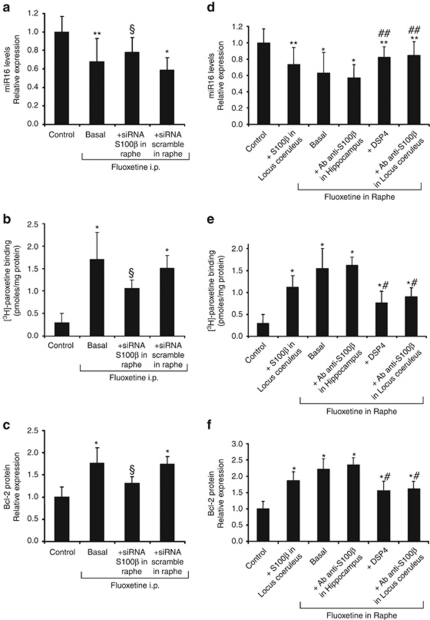Figure 2.
S100β released by raphe upon fluoxetine treatment does not act directly on the hippocampus but partially relays the fluoxetine response via the locus coeruleus. (a–c) Mice were chronically exposed to fluoxetine for 20 days (daily intraperitoneal injection, 5 mg kg−1, ‘basal' n=7). During the treatment, two groups of mice also received stereotaxic injection into the raphe of S100β-siRNA (2 μg, 1 μg μl−1, n=8) or scrambled oligonucleotides every 36 h (n=9). Control values were obtained in n=13 mice. The downregulation of miR-16 (real-time PCR) (a) and the upregulation of SERT ([3H]-paroxetine binding) (b) and bcl-2 protein levels (western blot analysis) (c) in the hippocampus after a 20-day intraperitoneal injection of fluoxetine in mice were partially abolished by siRNA-mediated knockdown of S100β in raphe. (d–f) Mice received a stereotaxic injection of S100β (1 n, 2 μl min−1, 1 day, n=7) in the locus coeruleus (LC). Alternatively, fluoxetine was perfused into the raphe either alone (‘basal' n=8) or combined with injection of S100β antibodies (1 μg ml−1) into the hippocampus (n=8) or the LC (n=7), or with degeneration of noradrenergic fibers with the DSP4 neurotoxin (n=7). Control values were obtained in n=12 mice. Hippocampal extracts from these different groups of mice were collected to quantify the miR-16 level (d), SERT (e) and bcl-2 (f) protein expression. The values are the means±s.e.m, *P<0.01 and **P<0.05 vs control, §P<0.05 vs scramble, #P<0.01 and ##P<0.05 vs basal fluoxetine in raphe.

